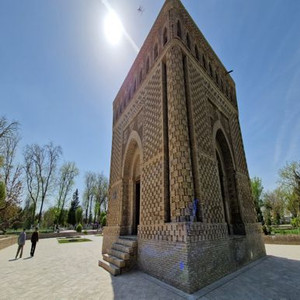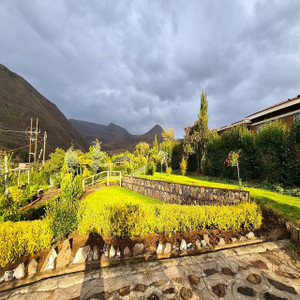
Duration: 10 days /9 nights
Activity level: Moderate
Tour months: Mid May- Late September (not available on 06-18 July because of the Naadam festival).
Tour highlights:
• Gobi Desert experience
• Ride two-humped Bactrian camels on sand dunes
• Flaming Cliffs, also known as the cradle of dinosaurs
• UNESCO’s world heritage site Orkhon Valley
• Authentic cultural experience with real nomadic families
• Staying at Mongolian Traditional Ger/Yurt
• Witness the last remaining wild horses on earth, the Przewalski horses, in their natural habitat and much more!
Trip takes us to the famous Gobi Desert and its massive sand dunes, including the Lammergeier Gorge and Flaming cliffs, and UNESCO World heritage site Orkhon valley national park, Genghis Khan’s Karakorum city, Hustai National Park, and the legendary monasteries of Erdenezuu in the beautiful Khangain mountains. Every day, we travel to new places for new attractions and adventures, such as gentle hiking in the wilderness, pay a visit to local nomadic families, riding horses in vast steppe and riding camels in the Gobi Desert.
Day 1: Arrival in Ulaanbaatar, private transfer to the hotel
Arrive in Ulaanbaatar, meet at the airport after custom formalities and transfer to your hotel. The remainder of the day is for you to get over jet lag and take a good rest before your wonderful journey across Mongolia.
Note: Normal check in time applies, 2 pm. If early check in needed, there will be extra cost
Accommodation: Holiday Inn Ulaanbaatar Hotel 4* or similar 1hr drive
Day 2: A Day trip to Terelj National Park
Meet your guide at 09:00 am in the hotel and walk to the Central Square of Mongolia named after Genghis Khan with 2 statues one dedicated to the Great Khan himself, and another to Sukhbaatar – a hero of Mongolian people’s revolution in 1921. Then, we will drive to beautiful Terelj National Park with the stop for the Giant Chinggis Khan statue, 40 m high stainless-steel statue. Continue our drive and arrive in the beautiful park within a short drive. Lunch in a ger restaurant in a camp. Visit naturally shaped Turtle Rock and Temple of Meditation. Enjoy one-hour horse ride around the national park. Transfer to Ulaanbaatar in the evening. Then you will be transferred to your accommodation in Ulaanbaatar.
Accommodation: Holiday Inn Ulaanbaatar Hotel 4* or similar B+L+D 1.5-2 hr drive one way
Day 3: The Gobi Desert - Yolyn Valley (aka Lammergeier Valley)
This morning, you will take local flight to Dalanzadgad town, South Gobi Province. Upon arrival, we hop on the road to the Gobi Gurvan Saikhan National Park. Your route passes the 'Three Beauties', the final peaks of the Altai Mountain range, crossing between the crags of the spectacular Dungenee Pass as you make your way to Yolyn Am and onwards to the lodge. Transfer to our ger camp with a visit to natural museum of the park on the way. Explore the National Park at leisure in the afternoon. Stay overnight at tourist camp.
Accommodation: Khan-Bogd ger camp or similar (standard ger or en-suite ger)
B+L+D 1.5 hr flight 3-4 hr drive
Day 4: Khongor Sand Dunes, Camel Ride
The drive to the dunes at Khongoriin that takes five to six hours and possibly lunch along the way. Lone gers and nomads on camelback hang suspended in the mirages, whilst the desert floor is strewn with a range of colorful rocks and unusual minerals. This is the Gobi at its stark best - there are many opportunities to stop and take photographs of the landscapes and people. Afternoon, we visit at camel herder family and do 2 hours camel riding to sand dunes. Then we start to climb the 300m high sand dunes. It gives us more challenge to see the beautiful sunset of the Gobi Desert.
Accommodation: Gobi Erdene ger camp or similar (standard ger or en-suite ger) B+L+D 5-6 hr drive
Day 5: Bayanzag/ The Flaming cliffs
Drive to the Bayanzag, also known as the Flaming Cliffs, where the first well-preserved dinosaur eggs were discovered in 1922 by Roy Chapman Andrews. Transfer to ger camp & lunch. In this huge paleontological site, you will have a chance to walk on the ground where dinosaurs once roamed 60 million years ago. Green desert plants stand in stark contrast to the red ground, and it is interesting to see many living reptiles, small lizards, camouflaged among the rocks and sand and seeking shelter around plants. The Mongolian name “Bayanzag” refers to the wealth of Saxaul (zag) bushes in the surrounding plains of the Flaming Cliffs.
Accommodation: Gobi tour ger camp or similar (standard ger or en-suite ger) B+L+D 3-4 hr drive
Day 6: Ongi Monastery Ruins
This morning, we will drive to Ongi monastery ruins by the River Ongi. Ongi Monastery was one of the biggest monasteries in Mongolia. There were two separate monasteries consisted of more than 30 temples on the shores of the Ongi River surrounded by the Gobi Desert mountains before they were destroyed by the communists in 1930s. Visit a ger museum, explore the monastery ruins and climb a nearby mountain to see views of the surrounding areas from an elevated area. Transfer to tourist ger camp, dinner and rest.
Accommodation: Secret of Ongi camp (only standard gers are available) B+L+D 3-3.5 hr drive
Day 7: Karakorum, the ancient capital of Mongol Empire
Today we drive to Karakorum- which used to serve as a capital of Mongol Empire and the passage of silk road in 13th century. Visit nomadic family along the way and enjoy typical Mongolian lunch. We visit legendary monastery Erdene Zuu and its surroundings. Hiking trail takes about 2-3 hours to the camp site. Overnight at a ger camp.
Accommodation: Munkh Tenger camp or similar (standard ger or en-suite ger) B+L+D 4-5 hr drive
Day 8: Hustai National Park
After breakfast, we will visit the Karakorum Museum and then drive to Hustai National park- where the Takhi wild horses graze peacefully with other wild animals. We will watch a short documentary about the national park, and then we head into the national park to spot the wild horse known as Takhi, birds and other wildlife. Overnight at the ger camp.
Accommodation: Hustai camp or similar (standard ger or en-suite ger) B+L+D 4-5 hr drive
Day 9: Ulaanbaatar
After breakfast, we will head to Ulaanbaatar city and start our city tour. The city tour of Ulaanbaatar takes you through some of the principal sights of this unique city. You visit the Gandan Monastery, housing a 26-meter-high gilded statue of the Buddha. Your tour also takes you to the Museum of National History, which has a number of fascinating displays of traditional Mongolian clothing and weaponry, as well as exhibits charting the course of Genghis Khan's empire-building. Afterwards visit the Bogd Khaan’s Palace Museum – the residence of the last king of Mongolia. Optional souvenir and cashmere shopping if you wish. Enjoy traditional folklore concert by the magical Tumen Ekh ensemble. Farewell dinner.
Accommodation: Holiday Inn Ulaanbaatar Hotel 4* or similar B+L+D 2-2.5 hr drive
Day 10: Departure from Ulaanbaatar, Mongolia.
You are transferred to the airport/train station after breakfast. End of service.
Accommodation: B – 1hr drive
Attraction Info

Giant Chinggis Equestrian Statue
Tsonjin boldog in total is 40m high from surface erected at about 10 m high foundation and surrounded by columns. The statue, Chinggis riding his horse, is made by 250 tonnage steel. It is largest horse-riding statue in the World. Far sighted Chinggis Khaan holds a golden whip in his right hand. The building consisted of 36 supporting columns, symbolizes 36 kings who are direct lineage of Chinggis Khaan.

Terelj National park
The third largest protected area in the country, Gorkhi Terelj National Park was established in 1993. The Gorkhi-Terelj National Park borders with the Khan Khentii Strictly Protected Area and receives the largest number of visitors due to its natural setting and proximity to Ulaanbaatar. Terelj is named after the Terelj River and is an area of endless slopes and valleys with high-eroded rock formations, mountains covered in dense forests.
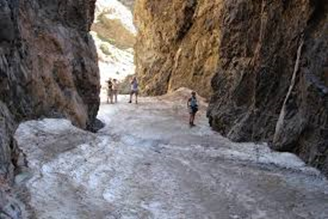
Yoliin Am
The bearded vulture, Yol in Mongolian, gave its name to the Yoliin Am Valley, the Gorge of Bearded Vultures. Located at a height of 2500 metres (8202,10 feet), Yol Canyon forms a gorge that is so deep and so narrow, that only two persons can pass in some places. The water forms four small waterfalls. Although the sun shines a lot in this region, the canyon remains dark, so that in the bottom, a part of the river remains nearly all year long covered by a thick layer of ice.

Khongor sand dunes
An extensive dune formation, Khongor Els runs for 180 kilometers across the front of the Gobi-Altai mountains - formed by deposits of sand dropped into the lee of the mountains by centuries of storms. The dunes, rising to heights of 2600 feet, stand out in light sinuous sand shapes against the dark rock of the mountain and the surrounding desert plain, At the base of the dunes runs a sacred river, bringing a flourish of green growth to the desert scene - the nomads bring their herds of cashmere goat and horses to drink at this oasis.
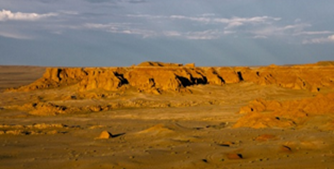
Bayanzag, The Flaming Cliffs
Bayanzag, which in Mongolian means 'a place of many saxaul bushes', was first called 'The Flaming Cliffs' by Roy Chapman Andrews, the American dinosaur hunter and adventurer who made vital finds of dinosaur eggs and skeletons at the base of the vivid red bluffs, which stand alone in a vast empty expanse of land and sky. Chapman himself was something of a rogue - said by some to be the man on whom the film character 'Indiana Jones' was based. He lived an adventurous, self-aggrandizing life across much of this part of the world. At Bayanzag it is the landscape, in addition to the rich dinosaur history, which is very impressive - an intense evocation of Mongolia's great emptiness.
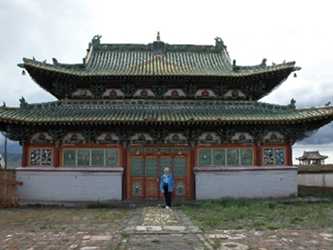
The Ancient Capital Karakorum
The ancient capital of Mongolia was established by Genghis Khan in 1220 in the Orkhon valley. For 140 years Kharkhorin served as the capital of the United Mongol tribes until it was destroyed by the Chinese troops in 1391. The remains of the capital that stood at the crossroads of the Silk Road are extensive underground archaeological assets and two granite turtles that once stood at the main gate to the city. Four of these turtle sculptures used to mark the boundaries of ancient Kharkhorin, acting as protectors of the city (turtles are considered symbols of eternity).

Erdene Zuu monastery
In 1586, Erdene Zuu, the first Buddhist monastery in Mongolia was built on the ruins of the 13th century capital. Vast walls of 400 m in length with 108 stupas surrounding the monastery are the symbol of Karakorum. Time and history were not merciful to Erdene Zuu monastery but it still carries the traces of its former glory and provides a great insight into the rich religious and cultural past of Mongolia.
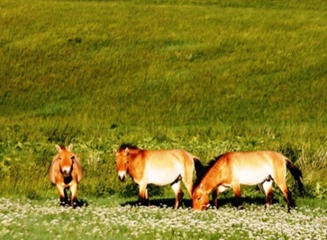
Hustai National park
The Mongolian Government declared Hustai National Park as a Specially Protected Area in 1993, one year after the initiation of the reintroduction project of the Takhi to the Hustain Nuruu.
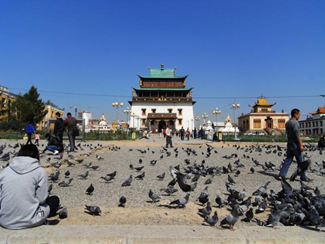
Gandan Monastery
The first temple of Gandantegchinleng Monastery was established in 1835 by the Fifth Jebtsundamba, the highest reincarnated lama of Mongolia. In the following years temples for daily service, veneration of Avalokiteshvara and colleges of Buddhist philosophy, medicine, astrology and tantric ritual were established. In 1938, Gandan Monastery was closed, but reopened in 1944 as the only functioning monastery during the socialist regime. After the democratic change took place in 1990 Buddhism regained its full right of worship. Gandan Monastery has, as being the Centre of Mongolian Buddhists, been striving to propagate peaceful teaching of Lord Buddha among family and society.
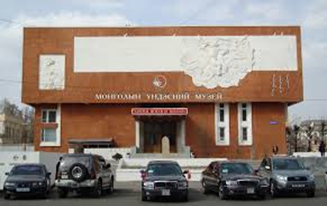
The National Museum of Mongolia
It is a cultural, scientific, and educational organization, which is responsible for the collection, conservation and interpretation of the objects under its curation. Exhibitions cover prehistory, pre-Mongol Empire history, Mongol Empire, Mongolia during Qing rule, ethnography and traditional life, and twentieth-century history. The ethnographic collection has significant displays of the traditional dress of various Mongolian ethnic groups and of snuff bottles.
Tour Price
• All prices displayed are subject to availability and can be withdrawn or varied without notice.
• Prices are guaranteed once booking is confirmed by us and paid in full by the due date.
• Depending on your needs and group size (individual, couple, family, group, etc.) we will provide the final pricing for your tour.
Inclusions:
• Full-time services of your English-speaking local guide(s) throughout the tour
• Sightseeing and entrance fees according to the itinerary
• Ticket to the Giant Genghis Monument Complex
• Private transfers (7-seater Japanese minivans in the countryside: 5 travellers per van; Minibuses or saloon cars in the city and around; + Experienced drivers)
• Airport transfers
• Twin/double room at centrally located 4-star hotel in Ulaanbaatar
• Twin share at good tourist camps (with shared public Western style bathroom)
• Meals as listed (B-breakfast, L-lunch, D-dinner)
• 1 hour Camel riding fees in the Gobi
• 1 hour Horse riding fees in Terelj NP or at other location
• Ulaanbaatar- Gobi flight ticket (10+5 kg luggage free)
• 0.5 l x 3 bottled water per day
• Visa support invitation letter where applicable
Exclusions:
• International Airfare/train tickets + Tax
• Travel insurance & Visa fees
• Items of a personal nature such as laundry, drinks, camera or video fees at any sites etc.
• Tips for your guide and driver (discretionary).
• Optional activities (horse/camel riding and archery)
Please refer to our Standard Booking Conditions for booking terms and conditions.














